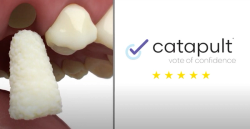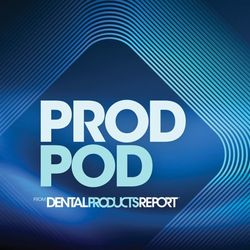- About Us
- Advertise
- Editorial
- Contact Us
- Terms and Conditions
- Privacy Policy
- Do Not Sell My Personal Information
© 2025 MJH Life Sciences™ and Dental Products Report. All rights reserved.
How to achieve long-lasting, natural-looking restorations
Shade-matching has always been one of the trickiest and most subtle parts of dentistry. In the past, dentists had to use countless materials of various shades to perfectly match a tooth, layering shades of materials and using several meticulous techniques to finally attain a natural-looking restoration.
However, as technology has advanced, we now have a plethora of new materials to simplify even our most complex procedures. OMNICHROMA, Tokuyama Dental’s one-shade universal composite, is one of the materials that has simplified my restorative procedures-and certainly many other dentists’. I have been using OMNICHROMA even before its public launch, and below I describe a case that demonstrates the longevity of OMNICHROMA’s shade-matching ability.
This restoration was completed in July of 2018. The patient is a 45-year-old female. At the initial exam, it was noted that the lower left first molar (tooth #19) had an old amalgam restoration on the occlusal, as well as sealant on the occlusal and buccal surfaces (Fig. 1). Both of these restorations were failing and had recurrent caries. It was determined that the tooth would need a new restoration in the form of an OB composite filling.
STEP 1
Bitewing and periapical X-rays were taken using a SUNI Digital X-ray system to make sure there were no interproximal caries or any periapical lesions. Furthermore, an intraoral photo taken with the CS1200 intraoral camera from Carestream Dental was used to present and confirm the caries before carrying out the treatment plan.
STEP 2
After using anesthetic with 2 percent Lidocaine with 1:100,000 epi, a rubber dam was placed. The existing amalgam and sealant (Figs. 1 and 2) were removed using a 806.31.009 inverted cone diamond bur from Brasseler USA, and a 6801.31.009 small round diamond bur also from Brasseler USA. The caries are visible in Figures 3 and 4.
Continue reading on the next page...
Figure 3
STEP 3
All the soft caries were removed using carbide round burs (sizes RA 2 and 4) with a Midwest Shorty slowspeed handpiece from Dentsply Sirona. To make a clean and neat cavity preparation, all the superficial caries and stains were removed conservatively with a small round diamond bur from Brasseler USA. Then an intraoral photo was taken to make sure no caries were left behind (Figs. 5 and 6).
Figure 7
STEP 4
After a clean and neat cavity preparation, TheraCal liner from BISCO was placed on the deep cavity surface as a protective liner and to mask the dark amalgam stain (Fig. 7). The liner was light-cured for 20 seconds using the Elipar FreeLight 2 from 3M. Then, a wide bevel was placed on the occlusal and buccal surfaces.
STEP 5
A selective enamel etching was done with 37 percent phosphoric acid, and then it was rinsed and dried. Tokuyama Universal Bond from Tokuyama Dental was placed and lightly air-dried. No light curing was needed for this bonding system.
Continue reading on the next page...
For this case, Tokuyama Dental’s one-shade universal composite, OMNICHROMA, was used as the composite material. This composite has great characteristics-it does not stick to hand instruments, it is easy to handle, it allows good working time, and it has a well-balanced consistency (not too soft nor too hard). It can be easily placed on the tooth and sculpted with hand instruments, and it polishes beautifully and blends naturally to the tooth.
STEP 6
OMNICHROMA was placed in small increments using
a condenser. Before light curing, some occlusal anatomy was
created using the following hand instruments-an acorn-shaped Hu-Friedy 21B Burnisher and a Pioneer Solution Blue Titanium CIB3. The photos (Figs. 8 and 9) show the composite before light curing.
Figures 10 and 11 show the shade-matching ability of OMNICHROMA after light curing; the material generated the natural color of the surrounding tooth with a single shade through structural color technology.
STEP 7
The occlusal adjustments and more detailed anatomy were created using an Axis 368018 C FG football-shaped diamond bur and a 685231.023 FG needle-shaped diamond bur from Brasseler USA.
STEP 8
The final finishing and polishing were done using a large coarse Sof-Lex disc from 3M, a DET4F FG fine needle diamond bur from Brasseler USA, and a White Arkansas Stone from Dedeco. Figs. 12 and 13 demonstrate the final restoration, which looks very natural after the occlusal adjustments and polishing.
Continue reading on the next page...
Impressive results, longevity
OMNICHROMA is incredibly unique in that it blends well with any tooth shade, even shades that
are normally challenging to match. For this case, I wanted to see how OMNICHROMA’s shade would change after light curing and how well it would blend to the tooth (Figs. 8-13). The final photos (Figs. 12 and 13) exemplify this composite’s shade-matching ability as it was able to match such a large restoration surface while matching all of the natural shade differences within the tooth.
OMNICHROMA is also universally indicated for almost every restorative case, including Class II, III, IV, and V restorations. Most frequently, I use it for Class V restorations-these are typically very challenging procedures due to the need to match the root surface of the tooth. With OMNICHROMA, however, this restoration is no longer a shade-matching nightmare because the one-shade composite can single-handedly match limitless tooth shades.
To confirm the longevity of OMNICHROMA’s shade-matching ability and to determine if Tokuyama Dental America’s promises with this product were true, a final photo of the restoration was taken in November of 2019, 15 months after the initial restoration was completed (Fig. 14).
I could not have been happier with this follow-up, as the restoration still looked incredible after more than a year and was continuing to generate the natural color of the surrounding tooth. I feel truly confident in OMNICHROMA’s ability to match a surrounding tooth’s color while also feeling at ease knowing that the pressure of choosing a perfect shade for a patient’s restoration no longer rests on my shoulders.
I also no longer need to supply my practice with many different composite shades to achieve natural-looking restorations, which is ultimately reducing my inventory and overhead costs.
As with any material, there are a few tips that I would recommend to other doctors using OMNICHROMA. In my opinion, the most important advice would be to always make a clean and neat cavity preparation without leaving any superficial caries and stains, because OMNICHROMA generates the color of the tooth based on whatever color is beneath and surrounding it. Any dark amalgam stains should be masked with an opaquer, such as OMNICHROMA’s supplementary material, OMNICHROMA BLOCKER.
I would also recommend making a wide bevel on the enamel surface so the composite can blend well with the existing enamel and dentin. Finally, use proper hand instruments and burs for occlusal anatomy to create natural-looking restorations.
What makes my practice different from others is our patients never leave our office without seeing before and after photos of my work. My patients are always very happy and reassured when they see the before and after photos of restorations completed with OMNICHROMA. And when it comes to me completing their own restorations, they are all happily surprised to see how well the composite adjusts to the surrounding tooth shade after light curing, blending perfectly to the tooth every time. The case described above is a perfect example of this composite in action, and the patient was very happy with the long-lasting final results.
OMNICHROMA
• The first universal composite that matches every patient’s tooth shade with a single shade of composite
• Saves time and money by removing the need for shade selecting and the need to keep excess product for incidental shades
• The red-to-yellow color combines with the reflected color of the patient’s surrounding dentition, to result in a perfect match with no added dyes or pigments
Tokuyama Dental America
877-378-3548 | omnichroma.com/us

 Download Issue: Dental Products Report February 2020
Download Issue: Dental Products Report February 2020

